Food, Nutrition, and Health October 07, 2022
Food, Nutrition, and Health
In collaboration with William Masters at Tufts University, we asked leaders, fellows, and awardees of the American Society of Nutrition and the Agricultural and Applied Economics Association about their views on nutrition. A total of 51 experts participated in the survey. More details and criteria for inclusion can be found here.
The questions and responses are summarized below. All information on this page is in the public domain and can be cited as:
Chris Said and William A. Masters (2022), Apollo Academic Survey on Food, Nutrition, and Health. Released 7 October 2022 at www.apollosurveys.org.
Primary results
Researchers thought that organic food would not improve health; cooking from home was one of the best ways to improve health; and changes in food composition was the leading cause of the obesity epidemic.- Organic foods: A large majority of researchers (78%) said that increasing use of organic food would have no effect on health.
- Cooking from home: The vast majority (92%) said that eating more food cooked at home would improve health outcomes.
- Specific nutrients: A large majority (83%) said more sugar-sweetened beverages would “greatly worsen” health. Beyond that, 58% said health would improve if we increased total protein. A large majority, 57%, favored an increase in plant oils.
- Causes of the obesity epidemic: 37% of researchers ranked changes in food composition and 27% ranked reduction in physical activity as the leading cause of the obesity epidemic.
-
Improving health:
- A large majority (90%) thought people’s health would improve if a larger fraction of their overall diet followed the Dietary Guidelines for Americans.
- Large majorities thought that eating more fruits and vegetables (96%), beans and lentils (90%), and whole grains (90%) would improve overall health and life expectancy.
-
Question 1
What do you believe caused the sharp rise in U.S. obesity rates since the mid-1970s, as shown by this chart of NHANES data among other sources?- • Higher incomes, allowing consumers to buy more of all foods
- • Change in prices of existing foods, leading consumers to buy less healthy & more unhealthy foods
- • Change in composition of available foods, from food manufacturers & restaurants
- • Change in marketing of foods, including more frequent snacking & larger portion sizes
- • Reduced physical activity, either at work or in everyday life
Results
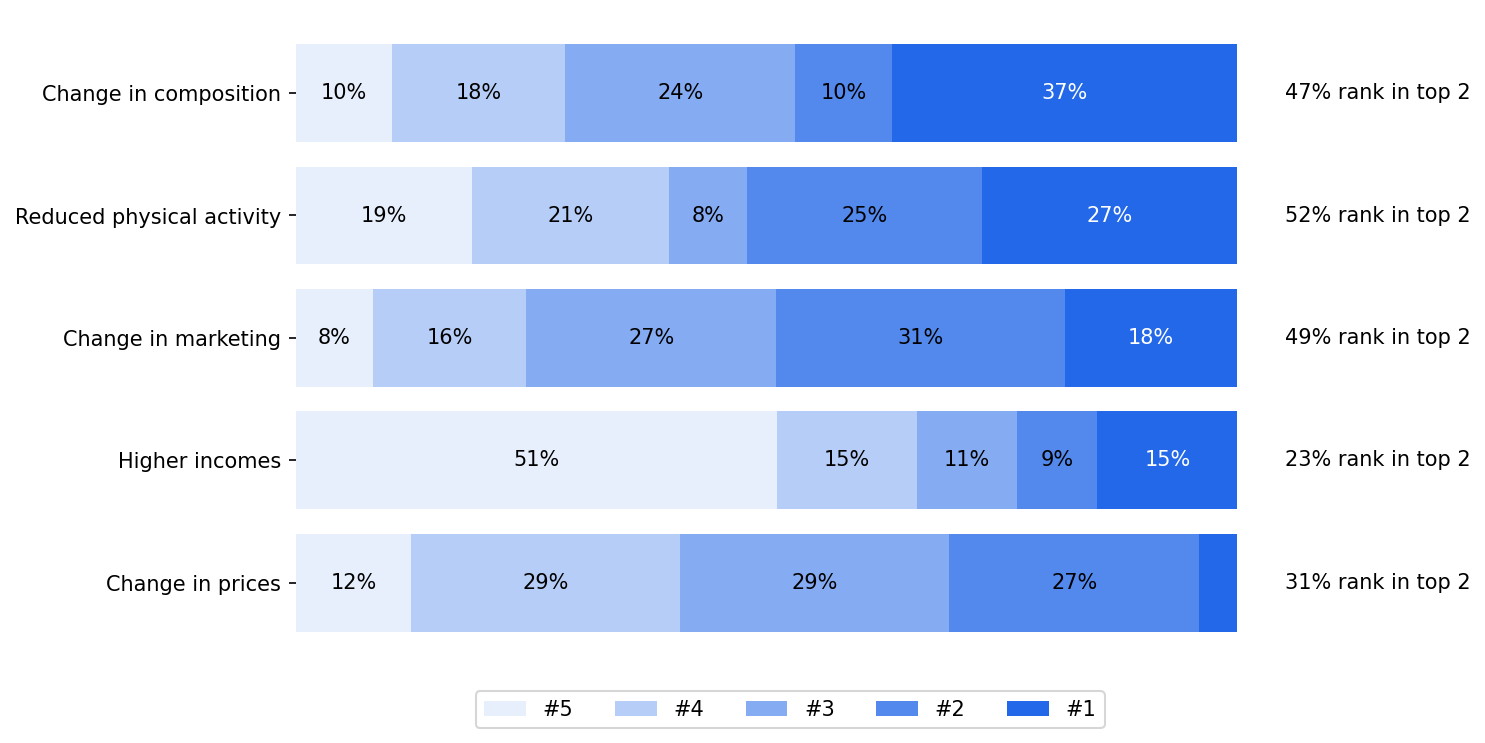
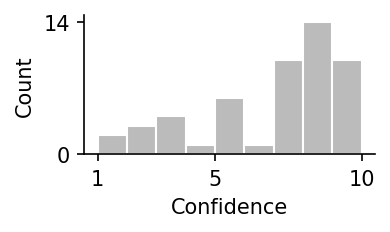
Participant Response Confidence Anonymous
Higher incomes: 1 Change in prices: 2 Change in composition: 3 Change in marketing: 5 Reduced physical activity: 4 8 Anonymous
Higher incomes: 5 Change in prices: 4 Change in composition: 3 Change in marketing: 2 Reduced physical activity: 1 8 Obesity is higher among the poor so higher income doesn't explain it. Lifestyle is more likely: less exercise, more food away from home. Anonymous
Higher incomes: 4 Change in prices: 3 Change in composition: 5 Change in marketing: 2 Reduced physical activity: 1 8 Anonymous
Higher incomes: Change in prices: Change in composition: Change in marketing: 1 Reduced physical activity: 10 Michael I. McBurney
University of Guelph and Tufts UniversityHigher incomes: 1 Change in prices: 4 Change in composition: 5 Change in marketing: 3 Reduced physical activity: 2 8 Choice of responses is limited. People choose what and where they eat. Food availability, working families, and time constraints are also important. Anonymous
Higher incomes: 5 Change in prices: 4 Change in composition: 2 Change in marketing: 3 Reduced physical activity: 1 5 Eileen Kennedy
Tufts UniversityHigher incomes: Change in prices: 3 Change in composition: 4 Change in marketing: 2 Reduced physical activity: 8 The all you can eat restaurant option is one of the worst changes since the 1970's Anonymous
Higher incomes: 4 Change in prices: 3 Change in composition: 5 Change in marketing: 1 Reduced physical activity: 2 7 You didn't explicitly include poverty or food insecurity, which I believe should have been the #1 reason. Anonymous
Higher incomes: 5 Change in prices: 3 Change in composition: 1 Change in marketing: 2 Reduced physical activity: 4 7 Do we have science to actually document the changes? And, are the causes the same across the country - as in impacting different demographics and SES in the same manner? Anonymous
Higher incomes: 5 Change in prices: 2 Change in composition: 3 Change in marketing: 1 Reduced physical activity: 4 8 Barry M. Popkin
University of North Carolina at Chapel HillHigher incomes: 3 Change in prices: 4 Change in composition: 1 Change in marketing: 2 Reduced physical activity: 5 2 Other than diet composition and increased snacking it is hard to truly understand the interaction between prices and income and their role in these shifts Thomas Wolever
University of TorontoHigher incomes: 5 Change in prices: 3 Change in composition: 4 Change in marketing: 2 Reduced physical activity: 1 2 Probably a combination of things and others not listed like screen time, use of food as a reward, design of buildings and neighbourhoods (low walkability), etc. Joanne Slavin
University of MinnesotaHigher incomes: 5 Change in prices: 4 Change in composition: 2 Change in marketing: 3 Reduced physical activity: 1 9 Anonymous
Higher incomes: 5 Change in prices: 4 Change in composition: 1 Change in marketing: 3 Reduced physical activity: 2 7 Anonymous
Higher incomes: 3 Change in prices: 4 Change in composition: 1 Change in marketing: 2 Reduced physical activity: 5 3 Anonymous
Higher incomes: 4 Change in prices: 5 Change in composition: 1 Change in marketing: 3 Reduced physical activity: 2 9 Anonymous
Higher incomes: 2 Change in prices: 1 Change in composition: 3 Change in marketing: 4 Reduced physical activity: 5 1 Eric Ravussin
Pennington BiomedicalHigher incomes: 5 Change in prices: 3 Change in composition: 1 Change in marketing: 2 Reduced physical activity: 4 7 It is a change in the environmental food availability with manufactured food being very palatable and quite cheap Anonymous
Higher incomes: 5 Change in prices: 2 Change in composition: 4 Change in marketing: 1 Reduced physical activity: 3 5 Anonymous
Higher incomes: 3 Change in prices: 2 Change in composition: 4 Change in marketing: 1 Reduced physical activity: 5 3 How can anyone claim to have high confidence in these factors? If it were clear, we might have effective obesity prevention. Anonymous
Higher incomes: 5 Change in prices: 3 Change in composition: 1 Change in marketing: 2 Reduced physical activity: 4 9 Anonymous
Higher incomes: 3 Change in prices: 2 Change in composition: 1 Change in marketing: 4 Reduced physical activity: 5 7 Anonymous
Higher incomes: 5 Change in prices: 4 Change in composition: 2 Change in marketing: 3 Reduced physical activity: 1 8 Anonymous
Higher incomes: 1 Change in prices: 3 Change in composition: 5 Change in marketing: 4 Reduced physical activity: 2 9 Anonymous
Higher incomes: Change in prices: Change in composition: Change in marketing: Reduced physical activity: 5 10 Anonymous
Higher incomes: 4 Change in prices: 5 Change in composition: 3 Change in marketing: 2 Reduced physical activity: 1 8 Nicola McKeown
Boston UniversityHigher incomes: 5 Change in prices: 3 Change in composition: 1 Change in marketing: 2 Reduced physical activity: 4 7 Barbara Gower
University of Alabama at BirminghamHigher incomes: Change in prices: 3 Change in composition: 1 Change in marketing: 2 Reduced physical activity: 10 Excess availability and consumption of highly processed grain-based, inexpensive, foods. Especially a problem in lower income groups. Anonymous
Higher incomes: 4 Change in prices: 2 Change in composition: 1 Change in marketing: 3 Reduced physical activity: 5 8 Highly processed and cheap carbohydrates are the primary problem. Anonymous
Higher incomes: 5 Change in prices: 4 Change in composition: 3 Change in marketing: 1 Reduced physical activity: 2 8 Anonymous
Higher incomes: 4 Change in prices: 5 Change in composition: 2 Change in marketing: 3 Reduced physical activity: 1 3 Jikun Huang
Peking UniversityHigher incomes: 5 Change in prices: 2 Change in composition: 1 Change in marketing: 3 Reduced physical activity: 4 7 David Zilberman
University of California, BerkeleyHigher incomes: 1 Change in prices: 2 Change in composition: 4 Change in marketing: 5 Reduced physical activity: 3 9 Anonymous
Higher incomes: 3 Change in prices: 4 Change in composition: 1 Change in marketing: 2 Reduced physical activity: 5 3 The relationship between these is hard to distinguish Barry Goodwin
Higher incomes: 5 Change in prices: 2 Change in composition: 3 Change in marketing: 4 Reduced physical activity: 1 9 Anonymous
Higher incomes: 1 Change in prices: 3 Change in composition: 4 Change in marketing: 5 Reduced physical activity: 2 1 Observed many immigrants who keep their traditional diet without using frequent snacks or manufactured foods, still get obese. Anonymous
Higher incomes: 4 Change in prices: 3 Change in composition: 1 Change in marketing: 2 Reduced physical activity: 5 5 Allen Featherstone
Kansas State UniversityHigher incomes: 2 Change in prices: 5 Change in composition: 4 Change in marketing: 3 Reduced physical activity: 1 9 Daniel A. Sumner
University of California, DavisHigher incomes: 5 Change in prices: 1 Change in composition: 4 Change in marketing: Reduced physical activity: 2 8 Odd that you label more snacking and eating big portions as "marketing." Maybe that is the problem. Obesity is up just about everywhere, so explanations need to be consistent with those data. How about bad nutrition advice for 30 years to avoid fat and eat carbs. Alfonso Morales
University of WisconsinHigher incomes: 5 Change in prices: 2 Change in composition: 3 Change in marketing: 1 Reduced physical activity: 4 5 Access to healthy food is a larger component and belongs in this list. Anonymous
Higher incomes: 5 Change in prices: 2 Change in composition: 3 Change in marketing: 4 Reduced physical activity: 1 8 Anonymous
Higher incomes: 5 Change in prices: 4 Change in composition: 1 Change in marketing: 3 Reduced physical activity: 2 2 Matin Qaim
University of BonnHigher incomes: 5 Change in prices: 3 Change in composition: 4 Change in marketing: 2 Reduced physical activity: 1 8 Parke Wilde
Tufts UniversityHigher incomes: 5 Change in prices: 2 Change in composition: 3 Change in marketing: 1 Reduced physical activity: 4 5 That was a challenging question, because you chose leading contenders. The public often emphasizes avoiding carbs, but I rank macronutrient composition lower than these. Anonymous
Higher incomes: 1 Change in prices: 5 Change in composition: 2 Change in marketing: 4 Reduced physical activity: 3 7 Dawn Thilmany
Colorado State UniversityHigher incomes: 5 Change in prices: 2 Change in composition: 3 Change in marketing: 1 Reduced physical activity: 4 6 Ken Meter
Crossroads Resource CenterHigher incomes: 5 Change in prices: 3 Change in composition: 1 Change in marketing: 4 Reduced physical activity: 2 8 Main element is High Fructose Corn Sweetener, but this also involves reducing prices of some foods and miserable marketing practices David Hennessy
Iowa State UniversityHigher incomes: 2 Change in prices: 4 Change in composition: 5 Change in marketing: 3 Reduced physical activity: 1 4 Change in household technology also important. More foods are ready-to-eat. Changing culture as in broken work activities, no taboo on eating between meals. Anonymous
Higher incomes: 5 Change in prices: 4 Change in composition: 1 Change in marketing: 3 Reduced physical activity: 2 5 Anonymous
Higher incomes: 1 Change in prices: 5 Change in composition: 3 Change in marketing: 4 Reduced physical activity: 2 7 Anonymous
Higher incomes: 2 Change in prices: 4 Change in composition: 1 Change in marketing: 5 Reduced physical activity: 3 7 -
Question 2
What do you believe should be the highest-priority policies or programs by which to improve nutrition and health for greater longevity and quality of life of the American people?- • Higher incomes for people in poverty, through either employment or social safety nets
- • Better access to healthy foods, through lower prices or vouchers and availability in local markets
- • Marketing regulations on unhealthy foods and drinks, with rules on what can be sold and how
- • Excise taxes on unhealthy foods and drinks, to raise price and discourage use such as soda taxes
- • Improvements in consumer decision-making, via education and empowerment
Results
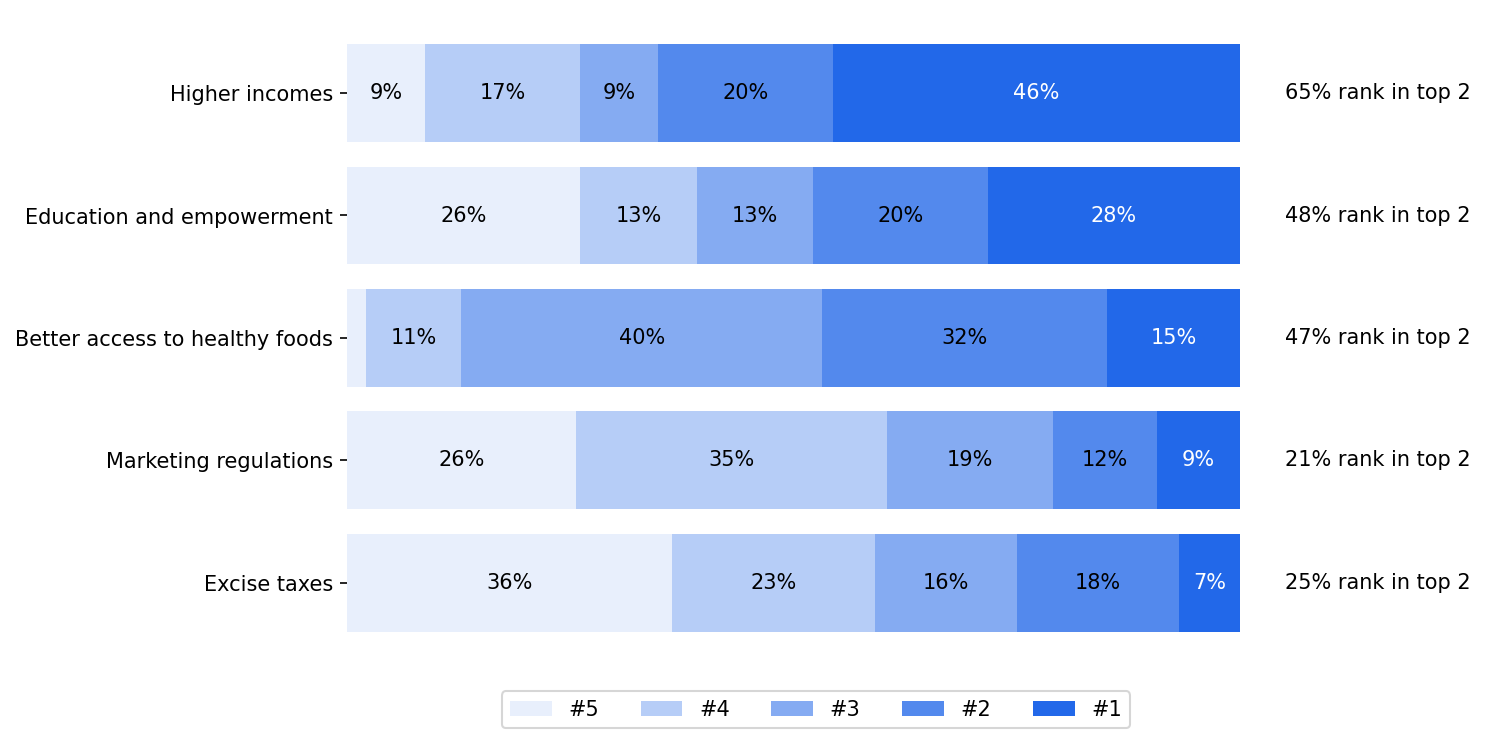
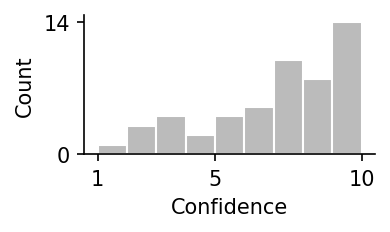
Participant Response Confidence Anonymous
Higher incomes: 1 Better access to healthy foods: 4 Marketing regulations: 3 Excise taxes: 5 Education and empowerment: 2 7 Anonymous
Higher incomes: 1 Better access to healthy foods: 3 Marketing regulations: 5 Excise taxes: 2 Education and empowerment: 4 7 I'll always put higher incomes for people in poverty as number one! Anonymous
Higher incomes: 2 Better access to healthy foods: 1 Marketing regulations: 5 Excise taxes: 4 Education and empowerment: 3 8 Anonymous
Higher incomes: Better access to healthy foods: 2 Marketing regulations: Excise taxes: 1 Education and empowerment: 10 Michael I. McBurney
University of Guelph and Tufts UniversityHigher incomes: 1 Better access to healthy foods: 2 Marketing regulations: 5 Excise taxes: 3 Education and empowerment: 4 7 Culture and values (dietary and lifestyle choices) and socioeconomics (income, environment) are important determinants of obesity. Obesity and malnutrition often co-exist. We do not know there relative impact on health and health costs. Anonymous
Higher incomes: 1 Better access to healthy foods: 3 Marketing regulations: 4 Excise taxes: 2 Education and empowerment: 5 8 Eileen Kennedy
Tufts UniversityHigher incomes: Better access to healthy foods: 1 Marketing regulations: Excise taxes: Education and empowerment: 9 Access to healthy food combined with effective nutrition communication campaigns Anonymous
Higher incomes: 2 Better access to healthy foods: 1 Marketing regulations: 4 Excise taxes: 5 Education and empowerment: 3 7 Anonymous
Higher incomes: 4 Better access to healthy foods: 1 Marketing regulations: 3 Excise taxes: 5 Education and empowerment: 2 5 The choices are not independent of each other. Also, impact will differ based on SDH - IMO! Anonymous
Higher incomes: 4 Better access to healthy foods: 1 Marketing regulations: 3 Excise taxes: 2 Education and empowerment: 5 6 Barry M. Popkin
University of North Carolina at Chapel HillHigher incomes: 3 Better access to healthy foods: 4 Marketing regulations: 2 Excise taxes: 1 Education and empowerment: 5 3 after taxes and total marketing controls it is hard to understand what is the key. Thomas Wolever
University of TorontoHigher incomes: 1 Better access to healthy foods: 2 Marketing regulations: 5 Excise taxes: 4 Education and empowerment: 3 2 There is wide disagreement about what is "healthy". Perhaps the most important issue is environmental degradation and the sustainability of our food system Joanne Slavin
University of MinnesotaHigher incomes: 1 Better access to healthy foods: 3 Marketing regulations: 4 Excise taxes: 5 Education and empowerment: 2 10 Anonymous
Higher incomes: 1 Better access to healthy foods: 2 Marketing regulations: 5 Excise taxes: 4 Education and empowerment: 3 8 Anonymous
Higher incomes: 1 Better access to healthy foods: 2 Marketing regulations: 3 Excise taxes: 4 Education and empowerment: 5 6 Anonymous
Higher incomes: 1 Better access to healthy foods: 3 Marketing regulations: 2 Excise taxes: 4 Education and empowerment: 5 8 Anonymous
Higher incomes: Better access to healthy foods: Marketing regulations: Excise taxes: Education and empowerment: Eric Ravussin
Pennington BiomedicalHigher incomes: 3 Better access to healthy foods: 4 Marketing regulations: 2 Excise taxes: 1 Education and empowerment: 5 8 Education from younger age is important. Anonymous
Higher incomes: 5 Better access to healthy foods: 3 Marketing regulations: 1 Excise taxes: 2 Education and empowerment: 4 5 Anonymous
Higher incomes: 2 Better access to healthy foods: 3 Marketing regulations: 4 Excise taxes: 5 Education and empowerment: 1 2 Anonymous
Higher incomes: 4 Better access to healthy foods: 3 Marketing regulations: 5 Excise taxes: 2 Education and empowerment: 1 5 Anonymous
Higher incomes: 2 Better access to healthy foods: 3 Marketing regulations: 4 Excise taxes: 5 Education and empowerment: 1 6 A major issue is defining a healthy food, need to focus on dietary patterns. healthy is often defined by level of a "bad" nutrient or level of processing, which can be inaccurate. Cheese has fat and sodium, but is not associated with CVD risk. Anonymous
Higher incomes: 1 Better access to healthy foods: 2 Marketing regulations: 4 Excise taxes: 3 Education and empowerment: 5 8 Anonymous
Higher incomes: 1 Better access to healthy foods: 3 Marketing regulations: 4 Excise taxes: 5 Education and empowerment: 2 7 Anonymous
Higher incomes: 4 Better access to healthy foods: Marketing regulations: Excise taxes: Education and empowerment: 5 10 Anonymous
Higher incomes: 2 Better access to healthy foods: 3 Marketing regulations: 4 Excise taxes: 5 Education and empowerment: 1 8 Nicola McKeown
Boston UniversityHigher incomes: 3 Better access to healthy foods: 2 Marketing regulations: 5 Excise taxes: 4 Education and empowerment: 1 6 Barbara Gower
University of Alabama at BirminghamHigher incomes: 4 Better access to healthy foods: 3 Marketing regulations: 1 Excise taxes: 5 Education and empowerment: 2 10 The heavy use of grain as a food component needs to be discouraged. Anonymous
Higher incomes: 4 Better access to healthy foods: 3 Marketing regulations: 2 Excise taxes: 5 Education and empowerment: 1 3 Anonymous
Higher incomes: 1 Better access to healthy foods: 2 Marketing regulations: 3 Excise taxes: 4 Education and empowerment: 5 8 Anonymous
Higher incomes: 2 Better access to healthy foods: 3 Marketing regulations: 4 Excise taxes: 5 Education and empowerment: 1 2 Jikun Huang
Peking UniversityHigher incomes: 5 Better access to healthy foods: 4 Marketing regulations: 2 Excise taxes: 3 Education and empowerment: 1 7 David Zilberman
University of California, BerkeleyHigher incomes: 1 Better access to healthy foods: 4 Marketing regulations: 3 Excise taxes: 2 Education and empowerment: 5 5 Anonymous
Higher incomes: 1 Better access to healthy foods: 2 Marketing regulations: 3 Excise taxes: 5 Education and empowerment: 4 4 Barry Goodwin
Higher incomes: 1 Better access to healthy foods: 3 Marketing regulations: 5 Excise taxes: 4 Education and empowerment: 2 9 Anonymous
Higher incomes: 5 Better access to healthy foods: 3 Marketing regulations: 4 Excise taxes: 2 Education and empowerment: 1 1 Anonymous
Higher incomes: Better access to healthy foods: Marketing regulations: Excise taxes: Education and empowerment: Allen Featherstone
Kansas State UniversityHigher incomes: 2 Better access to healthy foods: 3 Marketing regulations: 4 Excise taxes: 5 Education and empowerment: 1 8 Market choices are important. Personal responsibility is important. Daniel A. Sumner
University of California, DavisHigher incomes: 1 Better access to healthy foods: 3 Marketing regulations: Excise taxes: Education and empowerment: 2 8 Odd the question focuses on "foods" not diets. Nutritionists I work with refer to diets as unhealthy not foods. So taxes on foods and regulations of foods are odd. Alfonso Morales
University of WisconsinHigher incomes: 1 Better access to healthy foods: 2 Marketing regulations: 5 Excise taxes: 3 Education and empowerment: 4 7 Opportunities for active leisure, prescriptions for healthy exercise Anonymous
Higher incomes: 1 Better access to healthy foods: 3 Marketing regulations: 4 Excise taxes: 5 Education and empowerment: 2 9 Anonymous
Higher incomes: 3 Better access to healthy foods: 2 Marketing regulations: 1 Excise taxes: 4 Education and empowerment: 5 3 Matin Qaim
University of BonnHigher incomes: 5 Better access to healthy foods: 2 Marketing regulations: 4 Excise taxes: 3 Education and empowerment: 1 8 Parke Wilde
Tufts UniversityHigher incomes: 1 Better access to healthy foods: 2 Marketing regulations: 4 Excise taxes: 3 Education and empowerment: 5 7 Anonymous
Higher incomes: 4 Better access to healthy foods: 5 Marketing regulations: 1 Excise taxes: 2 Education and empowerment: 3 10 Dawn Thilmany
Colorado State UniversityHigher incomes: 2 Better access to healthy foods: 1 Marketing regulations: 3 Excise taxes: 5 Education and empowerment: 4 3 Ken Meter
Crossroads Resource CenterHigher incomes: 1 Better access to healthy foods: Marketing regulations: Excise taxes: Education and empowerment: 10 Unless the US funds local municipalities to design and build their own food systems few of these policy options will matter. Carbon tax would be interesting. David Hennessy
Iowa State UniversityHigher incomes: Better access to healthy foods: 2 Marketing regulations: Excise taxes: Education and empowerment: 1 4 Problem is to a large extent cultural. Also relates to rest of economy; employed, active people with responsibilities will tend to have better organized lives and care more about personal health. Anonymous
Higher incomes: 4 Better access to healthy foods: 1 Marketing regulations: 5 Excise taxes: 3 Education and empowerment: 2 8 Anonymous
Higher incomes: 2 Better access to healthy foods: 3 Marketing regulations: 5 Excise taxes: 4 Education and empowerment: 1 7 Anonymous
Higher incomes: 1 Better access to healthy foods: 2 Marketing regulations: 4 Excise taxes: 5 Education and empowerment: 3 6 -
Question 3
On balance, for overall health and average life expectancy of the U.S. population, what do you expect would be the effect for most people of having a larger fraction of their overall diet that follows the Dietary Guidelines for Americans, instead of the dietary patterns they now follow?Results
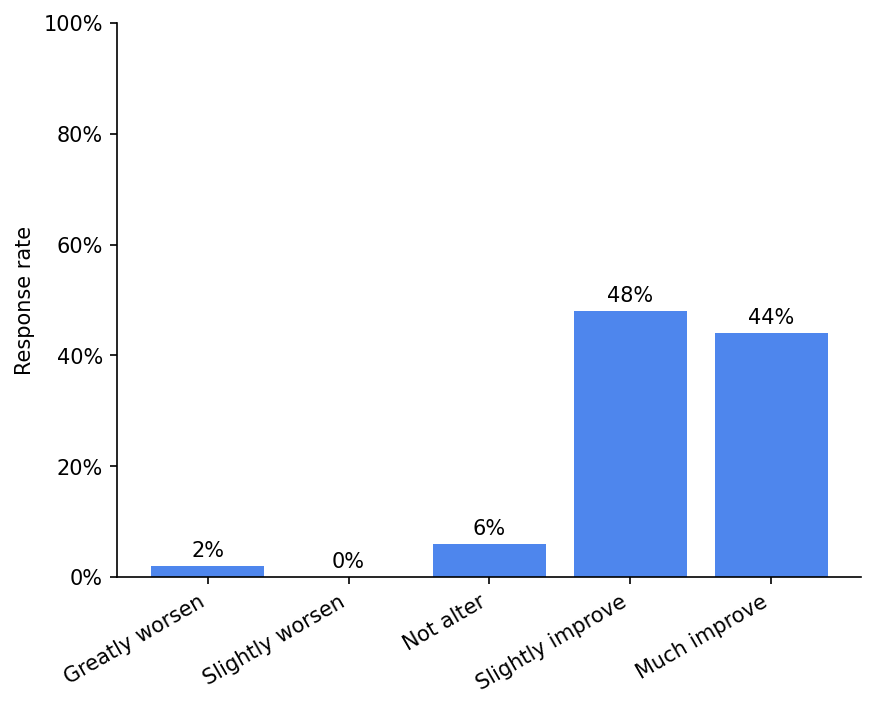
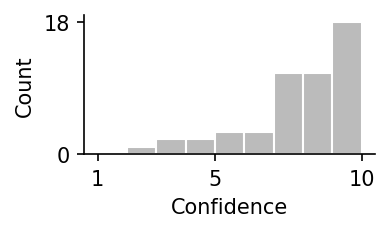
Participant Response Confidence Anonymous
Slightly improve 7 Anonymous
Slightly improve 7 Many lifestyle issues are at work, but following the DGA couldn't hurt. Anonymous
Slightly improve 8 Anonymous
Slightly improve 10 Michael I. McBurney
University of Guelph and Tufts UniversitySlightly improve 5 Caloric imbalance causes obesity. Weight loss studies show that macronutrient composition can be altered dramatically and achieve weight loss. Food patterns recommendations can stigmatize cultures. Greater focus on biomarkers of nutritional status (vs diet) is needed. Anonymous
Slightly improve 8 Eileen Kennedy
Tufts UniversityMuch improve 9 DGAs are important but unless they are promoted unlikely to have much affect in shifting dietary patterns. Anonymous
Much improve 8 Anonymous
Much improve 8 Have to adjust for current health status and environmental risk factors. Anonymous
Slightly improve 8 Barry M. Popkin
University of North Carolina at Chapel HillSlightly improve 3 This focuses on nutrients and ignores the large increase in ultra-processed food consumption among Americans. Thomas Wolever
University of TorontoSlightly improve 6 To be honest I am not confident I know the details of the US guidlines ... I know the Canadian ones better. Joanne Slavin
University of MinnesotaMuch improve 10 Anonymous
Slightly improve 10 Overall health and life expectancy are not the same thing Anonymous
Much improve 7 Anonymous
Much improve 10 Anonymous
Eric Ravussin
Pennington BiomedicalNot alter 7 The change in the environment has caused the pandemic of obesity. We have to reverse some of the obesogenic environment Anonymous
Slightly improve 8 Anonymous
Slightly improve 5 Diet is only one part of a healthy lifestyle. Alcohol, tobacco, drugs cost many lives. Anonymous
Much improve 10 Anonymous
Much improve 8 It depends how they follow them, various dietary patterns, i.e., vegetarian, can be healthy or unhealthy depending on the foods chosen Anonymous
Much improve 10 Anonymous
Much improve 9 Anonymous
Slightly improve 7 Anonymous
Much improve 10 Nicola McKeown
Boston UniversityMuch improve 10 Barbara Gower
University of Alabama at BirminghamNot alter 10 DAG may not reduce grain consumption. Whole grains are not necessarily healthful when used in heavily processed products such as breakfast cereals and bread. Anonymous
Greatly worsen 7 The Dietary Guidelines are responsible for the obesity pandemic that started 50 years ago Anonymous
Slightly improve 6 Anonymous
Much improve 3 Jikun Huang
Peking UniversitySlightly improve 8 David Zilberman
University of California, BerkeleyMuch improve 8 Anonymous
Slightly improve 7 Barry Goodwin
Much improve 9 Anonymous
Slightly improve 6 Anonymous
Slightly improve 5 Allen Featherstone
Kansas State UniversitySlightly improve 7 Daniel A. Sumner
University of California, DavisSlightly improve 10 Odd. So put the nutrition consultant in charge of the ration, like we do with dairy cows and hogs. I hope you see how fascist this sounds. Alfonso Morales
University of WisconsinSlightly improve 4 Anonymous
Much improve 10 Anonymous
Slightly improve 2 Matin Qaim
University of BonnMuch improve 10 Parke Wilde
Tufts UniversityMuch improve 8 Economists commonly undervalue the Dietary Guidelines for Americans, and may overstate uncertainties in nutrition science, but our economics profession might be wise to exercise a little more humility on this point sometimes. Anonymous
Much improve 10 Dawn Thilmany
Colorado State UniversitySlightly improve 7 There is lots of latitude in guidelines Ken Meter
Crossroads Resource CenterNot alter 7 Unless people are engaged with each other at a municipal or neighborhood level, guidelines will not matter much David Hennessy
Iowa State UniversityMuch improve 4 Death from diseases that are not diet related has declined, making diet a bigger factor in average life expectancy. But technologies to manage diet-related diseases have improved. I have no idea which is the more important in regard to determining overall population health.agement of diet Anonymous
Slightly improve 7 Anonymous
Much improve 10 Anonymous
Much improve 8 -
Question 4
On balance, for overall health and average life expectancy of the U.S. population, what do you expect would be the effect for most people of having a larger fraction of their overall diet that follows the Dietary Reference Intake (DRI) criteria, instead of the dietary patterns they now follow?Results
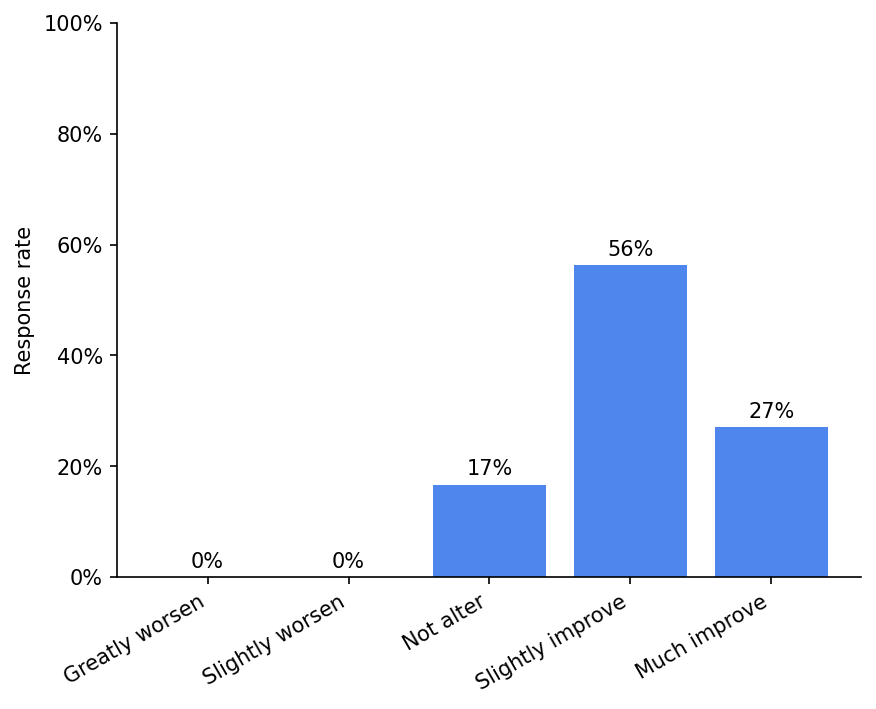
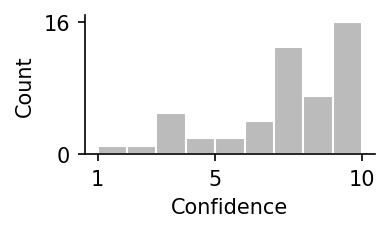
Participant Response Confidence Anonymous
Slightly improve 7 Anonymous
Slightly improve 3 Can't hurt, might help Anonymous
Slightly improve 8 Anonymous
Slightly improve 10 Michael I. McBurney
University of Guelph and Tufts UniversitySlightly improve 8 Meeting DRI for vitamins and minerals might dramatically change health risk. The data on food patterns is weak and often does not account for variation in micronutrients and other essential nutrients on health outcomes. Anonymous
Slightly improve 7 Eileen Kennedy
Tufts UniversityMuch improve 9 Preference should be given to foods as a source of nutrients. Anonymous
Slightly improve 7 The DRIs in form dietary guidelines but do not, themselves, have as much of an impact. People eat food, not just for the nutrients. Anonymous
Slightly improve 8 Anonymous
Not alter 7 Barry M. Popkin
University of North Carolina at Chapel HillNot alter 2 Thomas Wolever
University of TorontoMuch improve 6 I am thinking of meeting guidelines for potassium (reduces BP) and fiber (many beneficial effects) as major shortfall nutrients Joanne Slavin
University of MinnesotaMuch improve 10 Anonymous
Slightly improve 10 Anonymous
Much improve 7 Anonymous
Slightly improve 8 Anonymous
Eric Ravussin
Pennington BiomedicalSlightly improve 7 Anonymous
Not alter 8 Anonymous
Slightly improve 7 Anonymous
Much improve 10 Anonymous
Much improve 6 Dietary guidelines are built to have healthy dietary pattern and meet nutrients need Anonymous
Slightly improve 10 Anonymous
Much improve 9 Anonymous
Slightly improve 10 Anonymous
Slightly improve 10 Nicola McKeown
Boston UniversityMuch improve 10 Barbara Gower
University of Alabama at BirminghamNot alter 10 See comment for 12 above. Anonymous
Not alter 3 Anonymous
Anonymous
Much improve 3 Jikun Huang
Peking UniversitySlightly improve 7 David Zilberman
University of California, BerkeleySlightly improve 8 Anonymous
Slightly improve 6 Barry Goodwin
Slightly improve 8 Anonymous
Slightly improve 4 Anonymous
Allen Featherstone
Kansas State UniversitySlightly improve 7 Daniel A. Sumner
University of California, DavisMuch improve 10 Is this just being silly? How irrelevant can a quesiton be. Put a finacial consultant in charge of every families budget? Ask if people with be better off in general terms? Alfonso Morales
University of WisconsinSlightly improve 4 I do not know the science on this besides what I read in public media and magazines. Anonymous
Slightly improve 7 Anonymous
Not alter 5 DRI are based on calories, not carbs/sugars. It's the wrong measure. Matin Qaim
University of BonnMuch improve 10 Parke Wilde
Tufts UniversitySlightly improve 7 It is easier to satisfy the DRIs than to satisfy the Dietary Guidelines for Americans. Anonymous
Slightly improve 10 Dawn Thilmany
Colorado State UniversitySlightly improve 5 not sure how info is used Ken Meter
Crossroads Resource CenterNot alter 7 Unless people are engaged with each other at a municipal or neighborhood level, guidelines will not matter much David Hennessy
Iowa State UniversityMuch improve 4 Anonymous
Not alter 1 Anonymous
Much improve 10 Anonymous
Slightly improve 7 -
Question 5
On balance, for overall health and average life expectancy of the U.S. population, what do you expect would be the effect of more people having a larger fraction of their overall diet that- • Includes more fruits and vegetables, instead of other foods in current diets
- • Includes more cow’s milk and dairy, instead of other foods in current diets
- • Includes more beans and lentils, instead of other foods in current diets
- • Includes more eggs, instead of other protein-rich foods in current diets
- • Includes more fish, instead of other protein-rich foods in current diets
- • Includes more beef, instead of other protein-rich foods in current diets
- • Includes more nuts and seeds, instead of other foods in current diets
- • Includes more sugar-sweetened beverages, instead of other beverages in current diets
- • Includes more whole grains, instead of refined grains and simple carbohydrates such as potatoes
Results
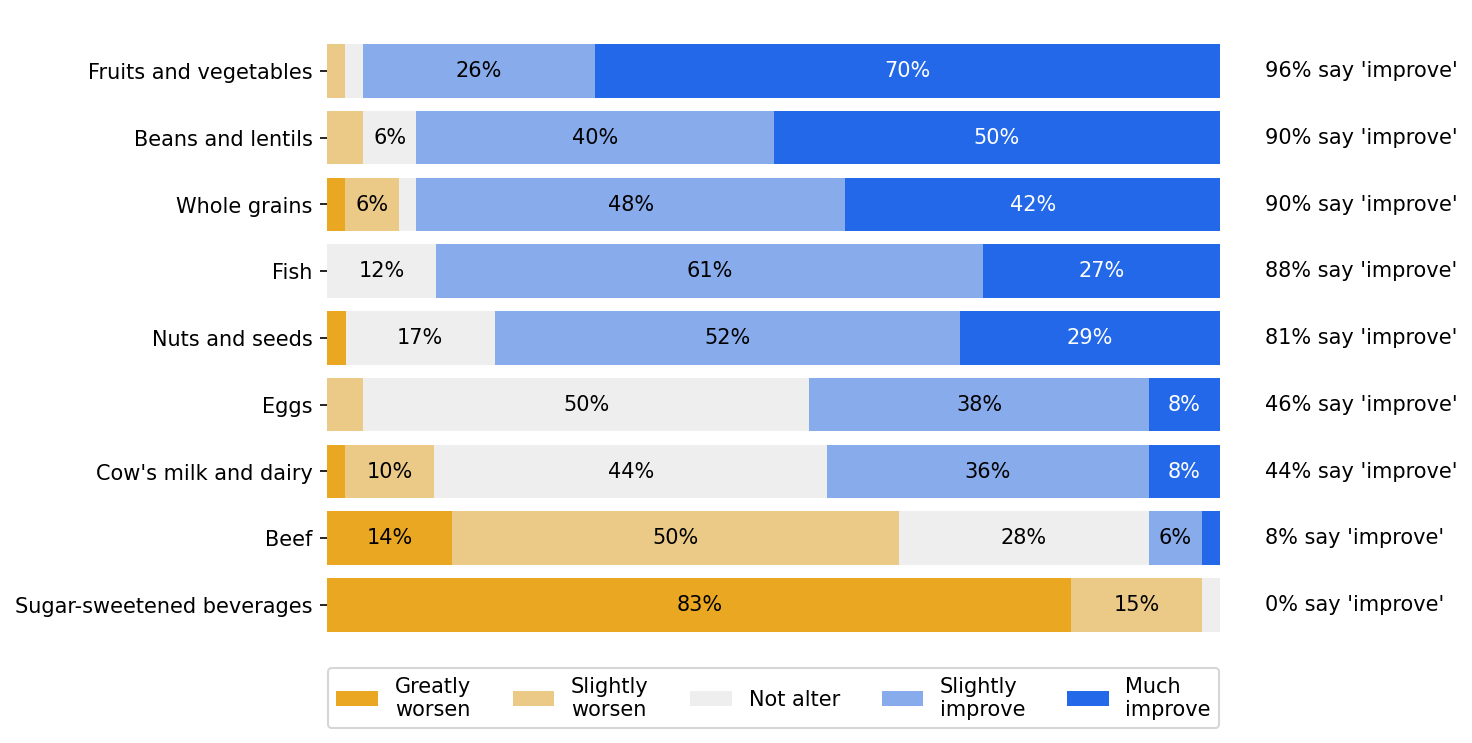
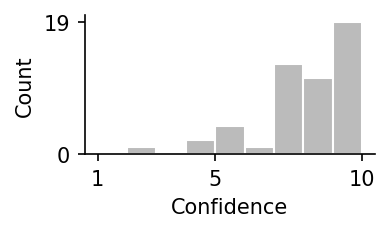
Participant Response Confidence Anonymous
Fruits and vegetables: Much improve Cow's milk and dairy: Much improve Beans and lentils: Slightly improve Eggs: Slightly improve Fish: Much improve Beef: Slightly worsen Nuts and seeds: Slightly improve Sugar-sweetened beverages: Greatly worsen Whole grains: Much improve 7 Anonymous
Fruits and vegetables: Much improve Cow's milk and dairy: Not alter Beans and lentils: Slightly improve Eggs: Slightly improve Fish: Much improve Beef: Slightly worsen Nuts and seeds: Much improve Sugar-sweetened beverages: Greatly worsen Whole grains: Much improve 9 Fish! Fruits and vegs! Nuts and seeds! (Beef only slightly worse because so much is already eaten.) Anonymous
Fruits and vegetables: Much improve Cow's milk and dairy: Slightly improve Beans and lentils: Slightly improve Eggs: Slightly improve Fish: Slightly improve Beef: Slightly improve Nuts and seeds: Slightly improve Sugar-sweetened beverages: Greatly worsen Whole grains: Slightly improve 8 Anonymous
Fruits and vegetables: Much improve Cow's milk and dairy: Slightly worsen Beans and lentils: Much improve Eggs: Not alter Fish: Much improve Beef: Not alter Nuts and seeds: Much improve Sugar-sweetened beverages: Greatly worsen Whole grains: Much improve 10 Michael I. McBurney
University of Guelph and Tufts UniversityFruits and vegetables: Slightly improve Cow's milk and dairy: Slightly improve Beans and lentils: Slightly improve Eggs: Slightly improve Fish: Slightly improve Beef: Not alter Nuts and seeds: Slightly improve Sugar-sweetened beverages: Greatly worsen Whole grains: Slightly improve 8 Isn't the question: Will the proposed change improve energy balance and/or be more likely to achieve optimal levels of nutrients to support the structure and function of cells, tissues and organs? Anonymous
Fruits and vegetables: Slightly improve Cow's milk and dairy: Not alter Beans and lentils: Slightly improve Eggs: Not alter Fish: Slightly improve Beef: Slightly worsen Nuts and seeds: Slightly improve Sugar-sweetened beverages: Greatly worsen Whole grains: Much improve 7 Eileen Kennedy
Tufts UniversityFruits and vegetables: Much improve Cow's milk and dairy: Slightly improve Beans and lentils: Much improve Eggs: Much improve Fish: Much improve Beef: Not alter Nuts and seeds: Much improve Sugar-sweetened beverages: Greatly worsen Whole grains: Much improve 9 Anonymous
Fruits and vegetables: Much improve Cow's milk and dairy: Slightly improve Beans and lentils: Much improve Eggs: Slightly improve Fish: Slightly improve Beef: Greatly worsen Nuts and seeds: Slightly improve Sugar-sweetened beverages: Greatly worsen Whole grains: Slightly improve 7 Anonymous
Fruits and vegetables: Much improve Cow's milk and dairy: Slightly improve Beans and lentils: Slightly improve Eggs: Not alter Fish: Not alter Beef: Slightly worsen Nuts and seeds: Not alter Sugar-sweetened beverages: Greatly worsen Whole grains: Slightly improve 7 Nutrients can be obtained from a variety of foods; a balance of health preparation impacts responses. Anonymous
Fruits and vegetables: Much improve Cow's milk and dairy: Not alter Beans and lentils: Much improve Eggs: Not alter Fish: Much improve Beef: Slightly worsen Nuts and seeds: Slightly improve Sugar-sweetened beverages: Greatly worsen Whole grains: Slightly improve 7 Barry M. Popkin
University of North Carolina at Chapel HillFruits and vegetables: Slightly improve Cow's milk and dairy: Slightly improve Beans and lentils: Slightly improve Eggs: Not alter Fish: Slightly improve Beef: Slightly worsen Nuts and seeds: Slightly improve Sugar-sweetened beverages: Greatly worsen Whole grains: Slightly improve 2 This ignored the 50-70% of ultra-processed quite unhealthy foods. Cutting them will be much more important Thomas Wolever
University of TorontoFruits and vegetables: Much improve Cow's milk and dairy: Not alter Beans and lentils: Much improve Eggs: Not alter Fish: Not alter Beef: Greatly worsen Nuts and seeds: Much improve Sugar-sweetened beverages: Greatly worsen Whole grains: Much improve 7 There is lots of evidence for many of these foods. Joanne Slavin
University of MinnesotaFruits and vegetables: Much improve Cow's milk and dairy: Much improve Beans and lentils: Slightly improve Eggs: Slightly improve Fish: Slightly improve Beef: Slightly improve Nuts and seeds: Slightly improve Sugar-sweetened beverages: Greatly worsen Whole grains: Much improve 10 Anonymous
Fruits and vegetables: Much improve Cow's milk and dairy: Not alter Beans and lentils: Slightly improve Eggs: Not alter Fish: Not alter Beef: Slightly worsen Nuts and seeds: Slightly improve Sugar-sweetened beverages: Greatly worsen Whole grains: Slightly improve 8 Anonymous
Fruits and vegetables: Much improve Cow's milk and dairy: Not alter Beans and lentils: Much improve Eggs: Slightly improve Fish: Slightly improve Beef: Not alter Nuts and seeds: Sugar-sweetened beverages: Whole grains: Slightly improve 7 Anonymous
Fruits and vegetables: Much improve Cow's milk and dairy: Not alter Beans and lentils: Much improve Eggs: Not alter Fish: Slightly improve Beef: Slightly worsen Nuts and seeds: Sugar-sweetened beverages: Whole grains: Much improve 10 Anonymous
Fruits and vegetables: Cow's milk and dairy: Beans and lentils: Eggs: Fish: Beef: Nuts and seeds: Sugar-sweetened beverages: Whole grains: Eric Ravussin
Pennington BiomedicalFruits and vegetables: Slightly improve Cow's milk and dairy: Not alter Beans and lentils: Slightly improve Eggs: Not alter Fish: Much improve Beef: Slightly worsen Nuts and seeds: Slightly improve Sugar-sweetened beverages: Greatly worsen Whole grains: Much improve 8 It's all about public health policies Anonymous
Fruits and vegetables: Much improve Cow's milk and dairy: Slightly improve Beans and lentils: Slightly improve Eggs: Not alter Fish: Slightly improve Beef: Not alter Nuts and seeds: Not alter Sugar-sweetened beverages: Greatly worsen Whole grains: Slightly improve 8 Anonymous
Fruits and vegetables: Slightly improve Cow's milk and dairy: Slightly improve Beans and lentils: Much improve Eggs: Not alter Fish: Slightly improve Beef: Not alter Nuts and seeds: Slightly improve Sugar-sweetened beverages: Greatly worsen Whole grains: Slightly improve 5 Anonymous
Fruits and vegetables: Much improve Cow's milk and dairy: Slightly improve Beans and lentils: Much improve Eggs: Slightly improve Fish: Much improve Beef: Slightly worsen Nuts and seeds: Much improve Sugar-sweetened beverages: Greatly worsen Whole grains: Much improve 9 Anonymous
Fruits and vegetables: Much improve Cow's milk and dairy: Much improve Beans and lentils: Much improve Eggs: Slightly improve Fish: Much improve Beef: Not alter Nuts and seeds: Much improve Sugar-sweetened beverages: Greatly worsen Whole grains: Much improve 8 Beef is nutrient rich and can be part of a healthy diet. Current consumption for most people in US does not need to be increased Anonymous
Fruits and vegetables: Much improve Cow's milk and dairy: Not alter Beans and lentils: Much improve Eggs: Slightly improve Fish: Much improve Beef: Slightly worsen Nuts and seeds: Much improve Sugar-sweetened beverages: Greatly worsen Whole grains: Much improve 9 Anonymous
Fruits and vegetables: Much improve Cow's milk and dairy: Slightly improve Beans and lentils: Much improve Eggs: Slightly improve Fish: Much improve Beef: Slightly worsen Nuts and seeds: Slightly improve Sugar-sweetened beverages: Not alter Whole grains: Much improve 8 Anonymous
Fruits and vegetables: Much improve Cow's milk and dairy: Slightly improve Beans and lentils: Much improve Eggs: Slightly improve Fish: Slightly improve Beef: Not alter Nuts and seeds: Much improve Sugar-sweetened beverages: Slightly worsen Whole grains: Much improve 10 Anonymous
Fruits and vegetables: Much improve Cow's milk and dairy: Slightly improve Beans and lentils: Much improve Eggs: Much improve Fish: Slightly improve Beef: Not alter Nuts and seeds: Slightly improve Sugar-sweetened beverages: Slightly worsen Whole grains: Much improve 9 Nicola McKeown
Boston UniversityFruits and vegetables: Slightly improve Cow's milk and dairy: Slightly improve Beans and lentils: Much improve Eggs: Slightly improve Fish: Slightly improve Beef: Slightly worsen Nuts and seeds: Much improve Sugar-sweetened beverages: Greatly worsen Whole grains: Much improve 7 Barbara Gower
University of Alabama at BirminghamFruits and vegetables: Slightly worsen Cow's milk and dairy: Not alter Beans and lentils: Slightly worsen Eggs: Not alter Fish: Not alter Beef: Not alter Nuts and seeds: Not alter Sugar-sweetened beverages: Greatly worsen Whole grains: Greatly worsen 10 Protein foods as meat, dairy, fish are fine. Humans have allergies and intolerances to many plant-based foods. Using plants as a protein source is dangerous. Anonymous
Fruits and vegetables: Not alter Cow's milk and dairy: Much improve Beans and lentils: Slightly worsen Eggs: Much improve Fish: Slightly improve Beef: Much improve Nuts and seeds: Not alter Sugar-sweetened beverages: Greatly worsen Whole grains: Not alter 10 Anonymous
Fruits and vegetables: Much improve Cow's milk and dairy: Slightly worsen Beans and lentils: Slightly improve Eggs: Not alter Fish: Not alter Beef: Greatly worsen Nuts and seeds: Much improve Sugar-sweetened beverages: Greatly worsen Whole grains: Much improve 8 Anonymous
Fruits and vegetables: Much improve Cow's milk and dairy: Slightly worsen Beans and lentils: Much improve Eggs: Slightly improve Fish: Slightly improve Beef: Slightly worsen Nuts and seeds: Slightly improve Sugar-sweetened beverages: Slightly worsen Whole grains: Slightly improve Jikun Huang
Peking UniversityFruits and vegetables: Much improve Cow's milk and dairy: Not alter Beans and lentils: Slightly improve Eggs: Slightly worsen Fish: Slightly improve Beef: Greatly worsen Nuts and seeds: Greatly worsen Sugar-sweetened beverages: Greatly worsen Whole grains: Slightly worsen 8 David Zilberman
University of California, BerkeleyFruits and vegetables: Slightly improve Cow's milk and dairy: Slightly improve Beans and lentils: Much improve Eggs: Much improve Fish: Much improve Beef: Slightly worsen Nuts and seeds: Slightly improve Sugar-sweetened beverages: Greatly worsen Whole grains: Slightly worsen 8 Anonymous
Fruits and vegetables: Much improve Cow's milk and dairy: Greatly worsen Beans and lentils: Much improve Eggs: Slightly improve Fish: Much improve Beef: Greatly worsen Nuts and seeds: Much improve Sugar-sweetened beverages: Greatly worsen Whole grains: Much improve 9 Barry Goodwin
Fruits and vegetables: Slightly improve Cow's milk and dairy: Not alter Beans and lentils: Much improve Eggs: Not alter Fish: Slightly improve Beef: Not alter Nuts and seeds: Much improve Sugar-sweetened beverages: Greatly worsen Whole grains: Slightly improve 9 Anonymous
Fruits and vegetables: Slightly improve Cow's milk and dairy: Slightly worsen Beans and lentils: Not alter Eggs: Not alter Fish: Slightly improve Beef: Slightly worsen Nuts and seeds: Slightly improve Sugar-sweetened beverages: Slightly worsen Whole grains: Slightly improve 4 Might have totally misunderstood, due to the same reason above Anonymous
Fruits and vegetables: Much improve Cow's milk and dairy: Not alter Beans and lentils: Much improve Eggs: Not alter Fish: Slightly improve Beef: Slightly worsen Nuts and seeds: Much improve Sugar-sweetened beverages: Greatly worsen Whole grains: Slightly improve 10 Allen Featherstone
Kansas State UniversityFruits and vegetables: Slightly improve Cow's milk and dairy: Slightly improve Beans and lentils: Not alter Eggs: Slightly improve Fish: Slightly improve Beef: Slightly improve Nuts and seeds: Slightly improve Sugar-sweetened beverages: Slightly worsen Whole grains: Slightly improve 7 Daniel A. Sumner
University of California, DavisFruits and vegetables: Much improve Cow's milk and dairy: Not alter Beans and lentils: Slightly improve Eggs: Not alter Fish: Slightly improve Beef: Slightly worsen Nuts and seeds: Not alter Sugar-sweetened beverages: Slightly worsen Whole grains: Slightly improve 5 Alfonso Morales
University of WisconsinFruits and vegetables: Much improve Cow's milk and dairy: Not alter Beans and lentils: Much improve Eggs: Slightly improve Fish: Beef: Slightly worsen Nuts and seeds: Slightly improve Sugar-sweetened beverages: Greatly worsen Whole grains: Slightly improve 6 In the aggregate the science may point to these responses, but individual health varies widely, which is why people ignore some promulgations. Anonymous
Fruits and vegetables: Much improve Cow's milk and dairy: Not alter Beans and lentils: Slightly improve Eggs: Not alter Fish: Slightly improve Beef: Slightly worsen Nuts and seeds: Not alter Sugar-sweetened beverages: Slightly worsen Whole grains: Slightly improve 7 Anonymous
Fruits and vegetables: Much improve Cow's milk and dairy: Not alter Beans and lentils: Much improve Eggs: Not alter Fish: Slightly improve Beef: Slightly worsen Nuts and seeds: Slightly improve Sugar-sweetened beverages: Greatly worsen Whole grains: Slightly worsen 5 Carbs/sugar vs other calories + need for proteins. Matin Qaim
University of BonnFruits and vegetables: Much improve Cow's milk and dairy: Not alter Beans and lentils: Slightly improve Eggs: Slightly worsen Fish: Slightly improve Beef: Slightly worsen Nuts and seeds: Slightly improve Sugar-sweetened beverages: Greatly worsen Whole grains: Much improve 8 Parke Wilde
Tufts UniversityFruits and vegetables: Much improve Cow's milk and dairy: Not alter Beans and lentils: Slightly improve Eggs: Not alter Fish: Slightly improve Beef: Slightly worsen Nuts and seeds: Slightly improve Sugar-sweetened beverages: Greatly worsen Whole grains: Slightly improve 7 Anonymous
Fruits and vegetables: Much improve Cow's milk and dairy: Not alter Beans and lentils: Much improve Eggs: Slightly improve Fish: Slightly improve Beef: Greatly worsen Nuts and seeds: Slightly improve Sugar-sweetened beverages: Greatly worsen Whole grains: Slightly improve 10 Dawn Thilmany
Colorado State UniversityFruits and vegetables: Slightly improve Cow's milk and dairy: Not alter Beans and lentils: Much improve Eggs: Not alter Fish: Slightly improve Beef: Not alter Nuts and seeds: Slightly improve Sugar-sweetened beverages: Greatly worsen Whole grains: Slightly improve 7 Lots of variance in some of those categories (dairy/beef/produce) Ken Meter
Crossroads Resource CenterFruits and vegetables: Much improve Cow's milk and dairy: Not alter Beans and lentils: Much improve Eggs: Not alter Fish: Much improve Beef: Greatly worsen Nuts and seeds: Much improve Sugar-sweetened beverages: Greatly worsen Whole grains: Much improve 9 Much also depends on pasture-raised livestock/eggs, and getting animals away from GMO grains David Hennessy
Iowa State UniversityFruits and vegetables: Slightly improve Cow's milk and dairy: Slightly improve Beans and lentils: Slightly improve Eggs: Not alter Fish: Slightly improve Beef: Slightly worsen Nuts and seeds: Slightly improve Sugar-sweetened beverages: Greatly worsen Whole grains: Slightly improve 4 Anonymous
Fruits and vegetables: Slightly improve Cow's milk and dairy: Slightly improve Beans and lentils: Not alter Eggs: Not alter Fish: Not alter Beef: Not alter Nuts and seeds: Not alter Sugar-sweetened beverages: Greatly worsen Whole grains: Slightly improve 5 Anonymous
Fruits and vegetables: Much improve Cow's milk and dairy: Slightly worsen Beans and lentils: Slightly improve Eggs: Not alter Fish: Slightly improve Beef: Slightly worsen Nuts and seeds: Slightly improve Sugar-sweetened beverages: Greatly worsen Whole grains: Slightly improve 7 Anonymous
Fruits and vegetables: Much improve Cow's milk and dairy: Slightly improve Beans and lentils: Slightly improve Eggs: Slightly improve Fish: Slightly improve Beef: Not alter Nuts and seeds: Not alter Sugar-sweetened beverages: Greatly worsen Whole grains: Much improve 9 -
Question 6
On balance, for overall health and average life expectancy of the U.S. population, what do you expect would be the effect of more people having a larger fraction of their overall diet that- • Includes more of all carbohydrates, instead of protein and fats
- • Includes more of all proteins, instead of fats and carbohydrates
- • Includes more of all fats, instead of protein and carbohydrates
- • Includes more plant oils, instead of other ingredients
- • Includes more added sugars, instead of other ingredients
- • Includes more added sodium, instead of other ingredients
Results
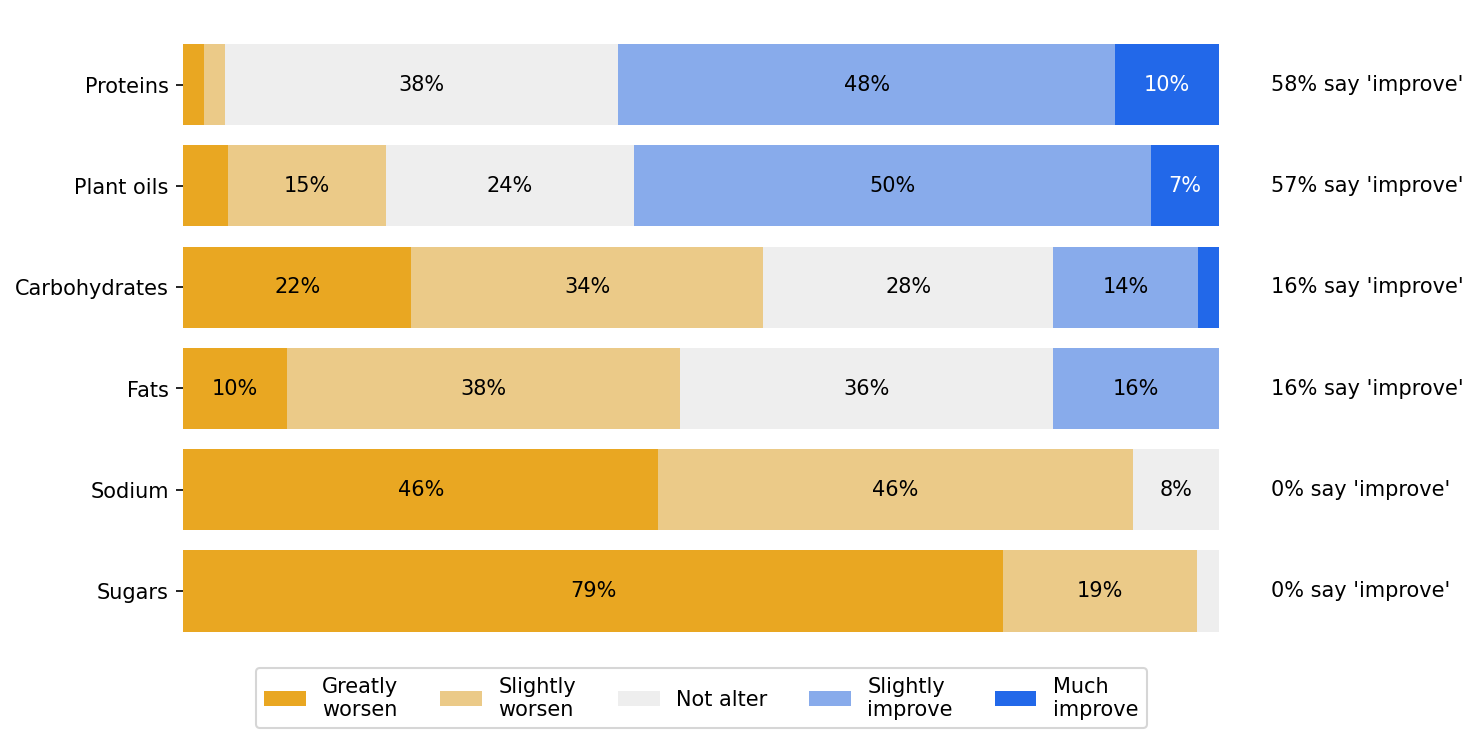

Participant Response Confidence Anonymous
Carbohydrates: Not alter Proteins: Slightly improve Fats: Greatly worsen Plant oils: Slightly improve Sugars: Greatly worsen Sodium: Greatly worsen 7 Anonymous
Carbohydrates: Not alter Proteins: Not alter Fats: Not alter Plant oils: Slightly improve Sugars: Greatly worsen Sodium: Greatly worsen 8 Since there are good and bad fats, CHO, ad protein, I said "won't alter". Anonymous
Carbohydrates: Slightly worsen Proteins: Slightly improve Fats: Slightly improve Plant oils: Slightly improve Sugars: Greatly worsen Sodium: Slightly worsen 8 Anonymous
Carbohydrates: Slightly worsen Proteins: Slightly worsen Fats: Slightly improve Plant oils: Greatly worsen Sugars: Greatly worsen Sodium: Greatly worsen 10 The most important variable may not be macronutrient composition, but overall calorie intake Michael I. McBurney
University of Guelph and Tufts UniversityCarbohydrates: Slightly improve Proteins: Slightly improve Fats: Not alter Plant oils: Slightly worsen Sugars: Slightly worsen Sodium: Slightly worsen 7 Anonymous
Carbohydrates: Not alter Proteins: Not alter Fats: Not alter Plant oils: Sugars: Greatly worsen Sodium: Slightly worsen 4 It is not approriate to lump all carbohydrates or all fats into one question. The sub-categories have differential impacts. Eileen Kennedy
Tufts UniversityCarbohydrates: Slightly improve Proteins: Slightly improve Fats: Slightly worsen Plant oils: Much improve Sugars: Greatly worsen Sodium: Greatly worsen 8 These questions were somewhat misleading. CHO should be complex CHOs - it was not possible to suggest this in the answer. Also for fats, type of fat is important Anonymous
Carbohydrates: Slightly worsen Proteins: Not alter Fats: Slightly worsen Plant oils: Slightly improve Sugars: Greatly worsen Sodium: Greatly worsen 7 Anonymous
Carbohydrates: Not alter Proteins: Not alter Fats: Not alter Plant oils: Slightly improve Sugars: Greatly worsen Sodium: Slightly worsen 7 Hard to answer from the perspective - what are carbohydrates? Unprocessed starches or highly processed? Anonymous
Carbohydrates: Slightly worsen Proteins: Not alter Fats: Slightly worsen Plant oils: Slightly improve Sugars: Greatly worsen Sodium: Greatly worsen 8 Barry M. Popkin
University of North Carolina at Chapel HillCarbohydrates: Slightly worsen Proteins: Slightly improve Fats: Slightly worsen Plant oils: Slightly worsen Sugars: Greatly worsen Sodium: Slightly worsen 2 Thomas Wolever
University of TorontoCarbohydrates: Not alter Proteins: Not alter Fats: Not alter Plant oils: Slightly improve Sugars: Slightly worsen Sodium: Slightly worsen 6 With respect to carbohydrate, protein and fat and health, it is the quality that matters, not the quanitity Joanne Slavin
University of MinnesotaCarbohydrates: Not alter Proteins: Not alter Fats: Not alter Plant oils: Slightly worsen Sugars: Greatly worsen Sodium: Slightly worsen 9 Anonymous
Carbohydrates: Not alter Proteins: Slightly improve Fats: Slightly worsen Plant oils: Slightly improve Sugars: Greatly worsen Sodium: Slightly worsen 8 Most of these questions are too vague about what you are replacing. Anonymous
Carbohydrates: Slightly worsen Proteins: Slightly improve Fats: Slightly improve Plant oils: Sugars: Sodium: 5 Anonymous
Carbohydrates: Slightly improve Proteins: Not alter Fats: Slightly worsen Plant oils: Sugars: Sodium: 8 Anonymous
Carbohydrates: Proteins: Fats: Plant oils: Sugars: Sodium: Eric Ravussin
Pennington BiomedicalCarbohydrates: Slightly improve Proteins: Not alter Fats: Slightly worsen Plant oils: Slightly improve Sugars: Greatly worsen Sodium: Greatly worsen 9 Anonymous
Carbohydrates: Slightly worsen Proteins: Not alter Fats: Not alter Plant oils: Not alter Sugars: Greatly worsen Sodium: Slightly worsen 5 Anonymous
Carbohydrates: Not alter Proteins: Not alter Fats: Not alter Plant oils: Slightly improve Sugars: Slightly worsen Sodium: Slightly worsen 5 Anonymous
Carbohydrates: Slightly worsen Proteins: Slightly improve Fats: Not alter Plant oils: Slightly improve Sugars: Greatly worsen Sodium: Greatly worsen 8 Anonymous
Carbohydrates: Greatly worsen Proteins: Slightly improve Fats: Slightly improve Plant oils: Slightly improve Sugars: Greatly worsen Sodium: Not alter 6 You can have a healthy or unhealthy low fat, high fat, low carb, etc. Depends on food choices Anonymous
Carbohydrates: Greatly worsen Proteins: Not alter Fats: Not alter Plant oils: Much improve Sugars: Greatly worsen Sodium: Slightly worsen 8 Anonymous
Carbohydrates: Not alter Proteins: Slightly improve Fats: Slightly worsen Plant oils: Slightly improve Sugars: Slightly worsen Sodium: Slightly worsen 7 Anonymous
Carbohydrates: Slightly worsen Proteins: Slightly improve Fats: Slightly worsen Plant oils: Slightly improve Sugars: Slightly worsen Sodium: Slightly worsen 9 Anonymous
Carbohydrates: Much improve Proteins: Not alter Fats: Slightly worsen Plant oils: Sugars: Slightly worsen Sodium: Slightly worsen 7 Nicola McKeown
Boston UniversityCarbohydrates: Slightly improve Proteins: Slightly improve Fats: Slightly worsen Plant oils: Slightly improve Sugars: Greatly worsen Sodium: Greatly worsen 8 Depends on the type of carbs Barbara Gower
University of Alabama at BirminghamCarbohydrates: Greatly worsen Proteins: Not alter Fats: Slightly improve Plant oils: Not alter Sugars: Greatly worsen Sodium: Not alter 6 Plant oils should be categorized; some are worse than others. Fat should replace carbs, but not proteins. Anonymous
Carbohydrates: Greatly worsen Proteins: Much improve Fats: Not alter Plant oils: Greatly worsen Sugars: Greatly worsen Sodium: Not alter 10 Anonymous
Carbohydrates: Slightly worsen Proteins: Slightly improve Fats: Not alter Plant oils: Slightly improve Sugars: Greatly worsen Sodium: Greatly worsen 9 Anonymous
Carbohydrates: Greatly worsen Proteins: Slightly improve Fats: Slightly improve Plant oils: Not alter Sugars: Greatly worsen Sodium: Slightly worsen 3 Jikun Huang
Peking UniversityCarbohydrates: Slightly improve Proteins: Not alter Fats: Greatly worsen Plant oils: Slightly worsen Sugars: Greatly worsen Sodium: Slightly worsen 8 David Zilberman
University of California, BerkeleyCarbohydrates: Greatly worsen Proteins: Much improve Fats: Slightly improve Plant oils: Slightly improve Sugars: Greatly worsen Sodium: Greatly worsen 8 Anonymous
Carbohydrates: Greatly worsen Proteins: Slightly improve Fats: Slightly worsen Plant oils: Much improve Sugars: Greatly worsen Sodium: Greatly worsen 7 Barry Goodwin
Carbohydrates: Greatly worsen Proteins: Slightly improve Fats: Greatly worsen Plant oils: Not alter Sugars: Greatly worsen Sodium: Greatly worsen 9 Anonymous
Carbohydrates: Greatly worsen Proteins: Much improve Fats: Slightly worsen Plant oils: Slightly worsen Sugars: Greatly worsen Sodium: Greatly worsen 4 same as above Anonymous
Carbohydrates: Not alter Proteins: Slightly improve Fats: Slightly worsen Plant oils: Slightly improve Sugars: Slightly worsen Sodium: Slightly worsen 10 Allen Featherstone
Kansas State UniversityCarbohydrates: Slightly worsen Proteins: Slightly improve Fats: Slightly worsen Plant oils: Not alter Sugars: Slightly worsen Sodium: Slightly worsen 4 Daniel A. Sumner
University of California, DavisCarbohydrates: Not alter Proteins: Not alter Fats: Not alter Plant oils: Not alter Sugars: Slightly worsen Sodium: Slightly worsen 5 These are all odd questions to ask economists. They are all the sort of questions to pose to hog nutrition consultants I guess. They do seem to reflect an attitude that questioners think of (other) people as livestock. Alfonso Morales
University of WisconsinCarbohydrates: Not alter Proteins: Not alter Fats: Not alter Plant oils: Not alter Sugars: Not alter Sodium: Not alter 1 I’m not qualified to have an opinion. Nor do I know the popular literature very well Anonymous
Carbohydrates: Not alter Proteins: Not alter Fats: Slightly worsen Plant oils: Not alter Sugars: Greatly worsen Sodium: Greatly worsen 8 Anonymous
Carbohydrates: Greatly worsen Proteins: Slightly improve Fats: Slightly improve Plant oils: Slightly improve Sugars: Greatly worsen Sodium: Slightly worsen 5 Matin Qaim
University of BonnCarbohydrates: Slightly worsen Proteins: Slightly improve Fats: Greatly worsen Plant oils: Slightly worsen Sugars: Greatly worsen Sodium: Greatly worsen 7 Parke Wilde
Tufts UniversityCarbohydrates: Slightly worsen Proteins: Not alter Fats: Not alter Plant oils: Slightly improve Sugars: Greatly worsen Sodium: Greatly worsen 7 For the "plant oils", I assumed unsaturated rather than palm oil. Anonymous
Carbohydrates: Slightly worsen Proteins: Slightly improve Fats: Not alter Plant oils: Slightly improve Sugars: Greatly worsen Sodium: Greatly worsen 10 Dawn Thilmany
Colorado State UniversityCarbohydrates: Slightly worsen Proteins: Much improve Fats: Slightly worsen Plant oils: Not alter Sugars: Greatly worsen Sodium: Slightly worsen 8 easier to do these than foods Ken Meter
Crossroads Resource CenterCarbohydrates: Greatly worsen Proteins: Greatly worsen Fats: Not alter Plant oils: Not alter Sugars: Greatly worsen Sodium: Greatly worsen 10 Once again, it is misleading to consider broad categories of food without knowing the faming practices behind each David Hennessy
Iowa State UniversityCarbohydrates: Slightly improve Proteins: Slightly improve Fats: Greatly worsen Plant oils: Slightly improve Sugars: Greatly worsen Sodium: Greatly worsen 3 Anonymous
Carbohydrates: Slightly worsen Proteins: Much improve Fats: Slightly worsen Plant oils: Not alter Sugars: Greatly worsen Sodium: Greatly worsen 7 Anonymous
Carbohydrates: Not alter Proteins: Slightly improve Fats: Slightly worsen Plant oils: Slightly improve Sugars: Greatly worsen Sodium: Greatly worsen 7 Anonymous
Carbohydrates: Slightly worsen Proteins: Slightly improve Fats: Not alter Plant oils: Slightly worsen Sugars: Greatly worsen Sodium: Slightly worsen 8 -
Question 7
On balance, for overall health and average life expectancy of the U.S. population, what do you expect would be the effect of more people having a larger fraction of their overall diet that- • Uses more foods produced under organic certification, instead of other methods now being used
- • Uses more foods cooked at home, instead of the restaurants where they now eat
- • Uses more foods processed using older methods, instead of the more recent processing now being used
- • Is made without sub-therapeutic antibiotics in livestock, instead of the practices now being used
- • Is made without growth hormones in cattle, instead of the practices now being used
- • Is made without pesticides and herbicides on plants, instead of the practices now being used
- • Is grown without genetically modified organisms (GMOs), instead of the varieties now being used
Results
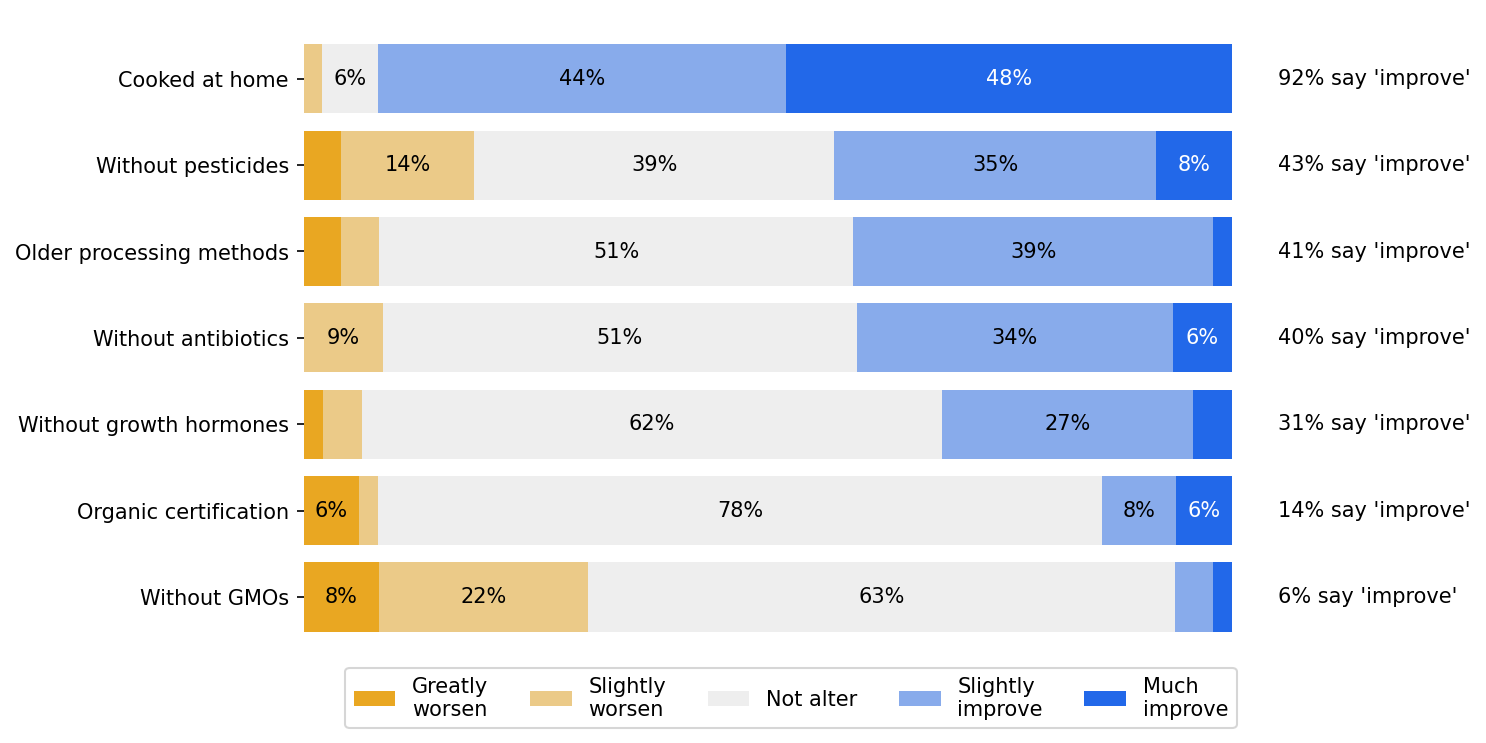
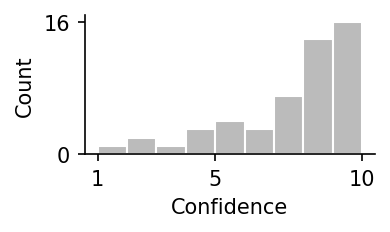
Participant Response Confidence Anonymous
Organic certification: Not alter Cooked at home: Much improve Older processing methods: Slightly improve Without antibiotics: Not alter Without growth hormones: Without pesticides: Slightly improve Without GMOs: Not alter 6 Anonymous
Organic certification: Not alter Cooked at home: Much improve Older processing methods: Slightly improve Without antibiotics: Slightly improve Without growth hormones: Slightly improve Without pesticides: Slightly improve Without GMOs: Not alter 7 Not too sure if I think lower pesticides, hormones, and antibiotics would greatly or only slightly affect. Anonymous
Organic certification: Not alter Cooked at home: Much improve Older processing methods: Slightly improve Without antibiotics: Slightly improve Without growth hormones: Slightly improve Without pesticides: Slightly improve Without GMOs: Not alter 8 Anonymous
Organic certification: Slightly improve Cooked at home: Slightly improve Older processing methods: Not alter Without antibiotics: Slightly improve Without growth hormones: Slightly improve Without pesticides: Slightly improve Without GMOs: Slightly improve 5 Michael I. McBurney
University of Guelph and Tufts UniversityOrganic certification: Not alter Cooked at home: Slightly improve Older processing methods: Greatly worsen Without antibiotics: Not alter Without growth hormones: Not alter Without pesticides: Not alter Without GMOs: Greatly worsen 8 Cooking at home is ONLY beneficial if it leads to better energy balance or higher intake of missing nutrients. Two important attributes, nutritional status and environmental concerns, that both affect health and lifespan cannot be answered this simplistically. Anonymous
Organic certification: Not alter Cooked at home: Slightly improve Older processing methods: Not alter Without antibiotics: Slightly improve Without growth hormones: Not alter Without pesticides: Not alter Without GMOs: Not alter 8 Eileen Kennedy
Tufts UniversityOrganic certification: Not alter Cooked at home: Slightly improve Older processing methods: Slightly improve Without antibiotics: Slightly improve Without growth hormones: Slightly improve Without pesticides: Slightly worsen Without GMOs: Not alter 8 Anonymous
Organic certification: Not alter Cooked at home: Much improve Older processing methods: Not alter Without antibiotics: Not alter Without growth hormones: Not alter Without pesticides: Not alter Without GMOs: Not alter 7 Anonymous
Organic certification: Not alter Cooked at home: Much improve Older processing methods: Slightly improve Without antibiotics: Not alter Without growth hormones: Not alter Without pesticides: Slightly worsen Without GMOs: Slightly worsen 4 Anonymous
Organic certification: Not alter Cooked at home: Much improve Older processing methods: Slightly improve Without antibiotics: Not alter Without growth hormones: Not alter Without pesticides: Not alter Without GMOs: Not alter 7 Barry M. Popkin
University of North Carolina at Chapel HillOrganic certification: Slightly improve Cooked at home: Slightly improve Older processing methods: Slightly improve Without antibiotics: Not alter Without growth hormones: Not alter Without pesticides: Slightly improve Without GMOs: Not alter 2 Thomas Wolever
University of TorontoOrganic certification: Not alter Cooked at home: Much improve Older processing methods: Not alter Without antibiotics: Not alter Without growth hormones: Not alter Without pesticides: Slightly improve Without GMOs: Not alter 3 Joanne Slavin
University of MinnesotaOrganic certification: Slightly worsen Cooked at home: Slightly improve Older processing methods: Not alter Without antibiotics: Not alter Without growth hormones: Not alter Without pesticides: Not alter Without GMOs: Not alter 8 As both a farmer and a scientist, I find these questions naive and uninformed. Farmers continue to use the best practices for growing plants and animlas and unless you are a producer, you don't appreciate the challenges. Anonymous
Organic certification: Not alter Cooked at home: Slightly improve Older processing methods: Slightly improve Without antibiotics: Not alter Without growth hormones: Not alter Without pesticides: Slightly improve Without GMOs: Slightly worsen 10 Anonymous
Organic certification: Not alter Cooked at home: Slightly improve Older processing methods: Slightly improve Without antibiotics: Slightly improve Without growth hormones: Slightly improve Without pesticides: Slightly improve Without GMOs: Not alter 5 Anonymous
Organic certification: Not alter Cooked at home: Much improve Older processing methods: Slightly improve Without antibiotics: Not alter Without growth hormones: Not alter Without pesticides: Not alter Without GMOs: Not alter 8 Anonymous
Organic certification: Cooked at home: Older processing methods: Without antibiotics: Without growth hormones: Without pesticides: Without GMOs: Eric Ravussin
Pennington BiomedicalOrganic certification: Much improve Cooked at home: Much improve Older processing methods: Greatly worsen Without antibiotics: Slightly improve Without growth hormones: Slightly improve Without pesticides: Much improve Without GMOs: Not alter 7 Anonymous
Organic certification: Not alter Cooked at home: Much improve Older processing methods: Not alter Without antibiotics: Not alter Without growth hormones: Not alter Without pesticides: Not alter Without GMOs: Not alter 8 Anonymous
Organic certification: Not alter Cooked at home: Slightly improve Older processing methods: Not alter Without antibiotics: Not alter Without growth hormones: Not alter Without pesticides: Not alter Without GMOs: Not alter 7 Anonymous
Organic certification: Much improve Cooked at home: Much improve Older processing methods: Slightly improve Without antibiotics: Slightly improve Without growth hormones: Slightly improve Without pesticides: Much improve Without GMOs: Not alter 8 Anonymous
Organic certification: Not alter Cooked at home: Slightly improve Older processing methods: Not alter Without antibiotics: Slightly worsen Without growth hormones: Not alter Without pesticides: Greatly worsen Without GMOs: Greatly worsen 8 There is nuance that could change the answers. Using growth hormones could improve productivity and reduce costs, which could improve nutrition/health. pesticides use will decrease with new technology for precision application Anonymous
Organic certification: Not alter Cooked at home: Much improve Older processing methods: Much improve Without antibiotics: Much improve Without growth hormones: Much improve Without pesticides: Much improve Without GMOs: Not alter 8 Anonymous
Organic certification: Not alter Cooked at home: Slightly improve Older processing methods: Not alter Without antibiotics: Slightly improve Without growth hormones: Slightly improve Without pesticides: Not alter Without GMOs: Not alter 8 Anonymous
Organic certification: Not alter Cooked at home: Slightly improve Older processing methods: Not alter Without antibiotics: Slightly worsen Without growth hormones: Slightly worsen Without pesticides: Slightly worsen Without GMOs: Slightly worsen 10 Anonymous
Organic certification: Not alter Cooked at home: Slightly improve Older processing methods: Not alter Without antibiotics: Not alter Without growth hormones: Not alter Without pesticides: Not alter Without GMOs: Not alter 10 Nicola McKeown
Boston UniversityOrganic certification: Not alter Cooked at home: Much improve Older processing methods: Not alter Without antibiotics: Not alter Without growth hormones: Not alter Without pesticides: Slightly improve Without GMOs: Not alter 6 Barbara Gower
University of Alabama at BirminghamOrganic certification: Slightly improve Cooked at home: Much improve Older processing methods: Not alter Without antibiotics: Not alter Without growth hormones: Not alter Without pesticides: Not alter Without GMOs: Not alter 9 Anonymous
Organic certification: Not alter Cooked at home: Slightly improve Older processing methods: Slightly improve Without antibiotics: Not alter Without growth hormones: Not alter Without pesticides: Not alter Without GMOs: Not alter 10 Anonymous
Organic certification: Not alter Cooked at home: Much improve Older processing methods: Slightly improve Without antibiotics: Without growth hormones: Not alter Without pesticides: Not alter Without GMOs: Not alter Anonymous
Organic certification: Not alter Cooked at home: Much improve Older processing methods: Not alter Without antibiotics: Not alter Without growth hormones: Not alter Without pesticides: Not alter Without GMOs: Not alter 2 Jikun Huang
Peking UniversityOrganic certification: Slightly improve Cooked at home: Much improve Older processing methods: Slightly improve Without antibiotics: Slightly improve Without growth hormones: Slightly improve Without pesticides: Slightly improve Without GMOs: Slightly worsen 8 David Zilberman
University of California, BerkeleyOrganic certification: Greatly worsen Cooked at home: Much improve Older processing methods: Slightly improve Without antibiotics: Not alter Without growth hormones: Slightly improve Without pesticides: Not alter Without GMOs: Greatly worsen 9 Anonymous
Organic certification: Not alter Cooked at home: Slightly improve Older processing methods: Not alter Without antibiotics: Not alter Without growth hormones: Not alter Without pesticides: Slightly improve Without GMOs: Not alter 7 Barry Goodwin
Organic certification: Greatly worsen Cooked at home: Slightly worsen Older processing methods: Slightly worsen Without antibiotics: Slightly worsen Without growth hormones: Greatly worsen Without pesticides: Greatly worsen Without GMOs: Greatly worsen 9 Anonymous
Organic certification: Not alter Cooked at home: Slightly improve Older processing methods: Not alter Without antibiotics: Slightly improve Without growth hormones: Not alter Without pesticides: Slightly improve Without GMOs: Not alter 1 Anonymous
Organic certification: Not alter Cooked at home: Much improve Older processing methods: Without antibiotics: Without growth hormones: Without pesticides: Without GMOs: Allen Featherstone
Kansas State UniversityOrganic certification: Not alter Cooked at home: Slightly improve Older processing methods: Not alter Without antibiotics: Not alter Without growth hormones: Not alter Without pesticides: Not alter Without GMOs: Slightly worsen Daniel A. Sumner
University of California, DavisOrganic certification: Greatly worsen Cooked at home: Slightly improve Older processing methods: Slightly worsen Without antibiotics: Slightly worsen Without growth hormones: Slightly worsen Without pesticides: Slightly worsen Without GMOs: Slightly worsen 8 The economics behind this set of questions is: Would people have better diets if food were more expensive and perhaps much more expensive. Alfonso Morales
University of WisconsinOrganic certification: Not alter Cooked at home: Slightly improve Older processing methods: Not alter Without antibiotics: Not alter Without growth hormones: Slightly improve Without pesticides: Slightly improve Without GMOs: Slightly improve 5 The question assumes steady increase in life expectancy. I don’t think he assumption is viable. Anonymous
Organic certification: Not alter Cooked at home: Much improve Older processing methods: Slightly improve Without antibiotics: Not alter Without growth hormones: Not alter Without pesticides: Not alter Without GMOs: Not alter 10 Anonymous
Organic certification: Not alter Cooked at home: Much improve Older processing methods: Not alter Without antibiotics: Not alter Without growth hormones: Not alter Without pesticides: Slightly worsen Without GMOs: Slightly worsen 4 The risks of pesticides, GMOs, etc, tend to be overstated/overblown compared to other risks, such as sugar, processed food, etc, and this biases policy. I am not saying pesticides are not potentially dangerous, only that 'the practices now being used' in the US minimize the risk already. Matin Qaim
University of BonnOrganic certification: Not alter Cooked at home: Slightly improve Older processing methods: Not alter Without antibiotics: Slightly improve Without growth hormones: Not alter Without pesticides: Slightly worsen Without GMOs: Slightly worsen 7 Parke Wilde
Tufts UniversityOrganic certification: Not alter Cooked at home: Slightly improve Older processing methods: Slightly improve Without antibiotics: Slightly improve Without growth hormones: Not alter Without pesticides: Slightly improve Without GMOs: Not alter 6 Anonymous
Organic certification: Not alter Cooked at home: Not alter Older processing methods: Not alter Without antibiotics: Slightly improve Without growth hormones: Not alter Without pesticides: Not alter Without GMOs: Not alter 9 Dawn Thilmany
Colorado State UniversityOrganic certification: Not alter Cooked at home: Slightly improve Older processing methods: Slightly improve Without antibiotics: Not alter Without growth hormones: Not alter Without pesticides: Slightly improve Without GMOs: Not alter 8 fairly good science, but cooking methods is broad statement Ken Meter
Crossroads Resource CenterOrganic certification: Much improve Cooked at home: Much improve Older processing methods: Not alter Without antibiotics: Much improve Without growth hormones: Much improve Without pesticides: Much improve Without GMOs: Much improve 10 It is not clear what is meant by "older methods." If traditional and indigenous methods, improvement. If post-war cooking recommendations, worse outcomes David Hennessy
Iowa State UniversityOrganic certification: Not alter Cooked at home: Much improve Older processing methods: Slightly improve Without antibiotics: Without growth hormones: Not alter Without pesticides: Not alter Without GMOs: Slightly worsen 4 Anonymous
Organic certification: Not alter Cooked at home: Not alter Older processing methods: Not alter Without antibiotics: Slightly improve Without growth hormones: Slightly improve Without pesticides: Slightly improve Without GMOs: Slightly worsen 5 Anonymous
Organic certification: Not alter Cooked at home: Much improve Older processing methods: Not alter Without antibiotics: Much improve Without growth hormones: Slightly improve Without pesticides: Slightly improve Without GMOs: Not alter 9 Anonymous
Organic certification: Not alter Cooked at home: Not alter Older processing methods: Not alter Without antibiotics: Slightly improve Without growth hormones: Not alter Without pesticides: Slightly worsen Without GMOs: Slightly worsen 9
